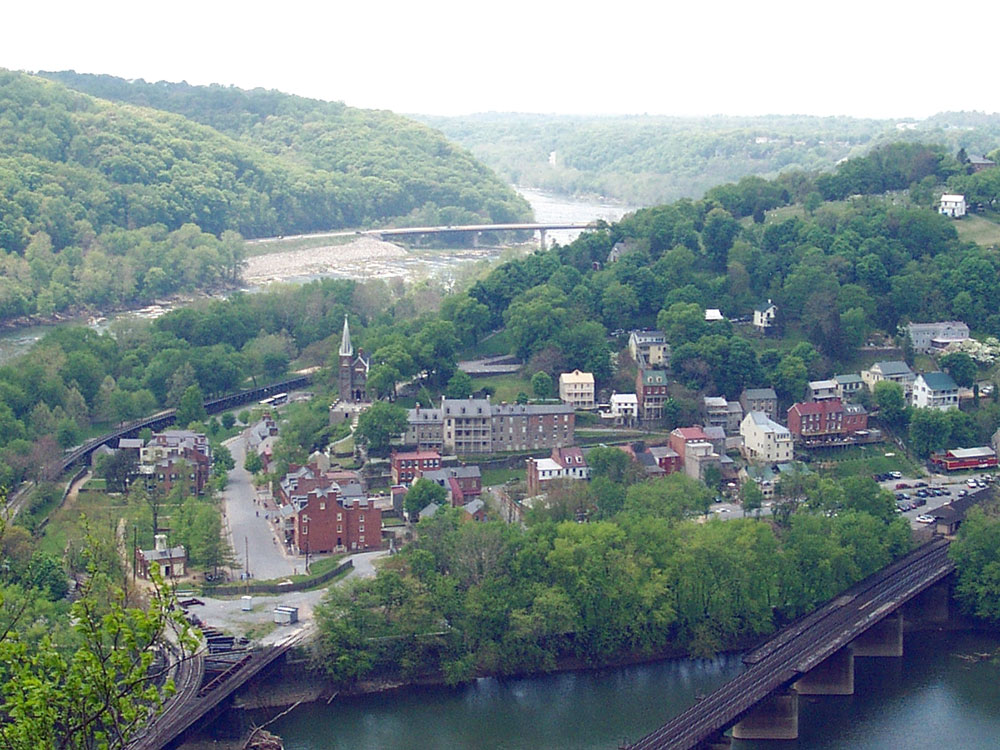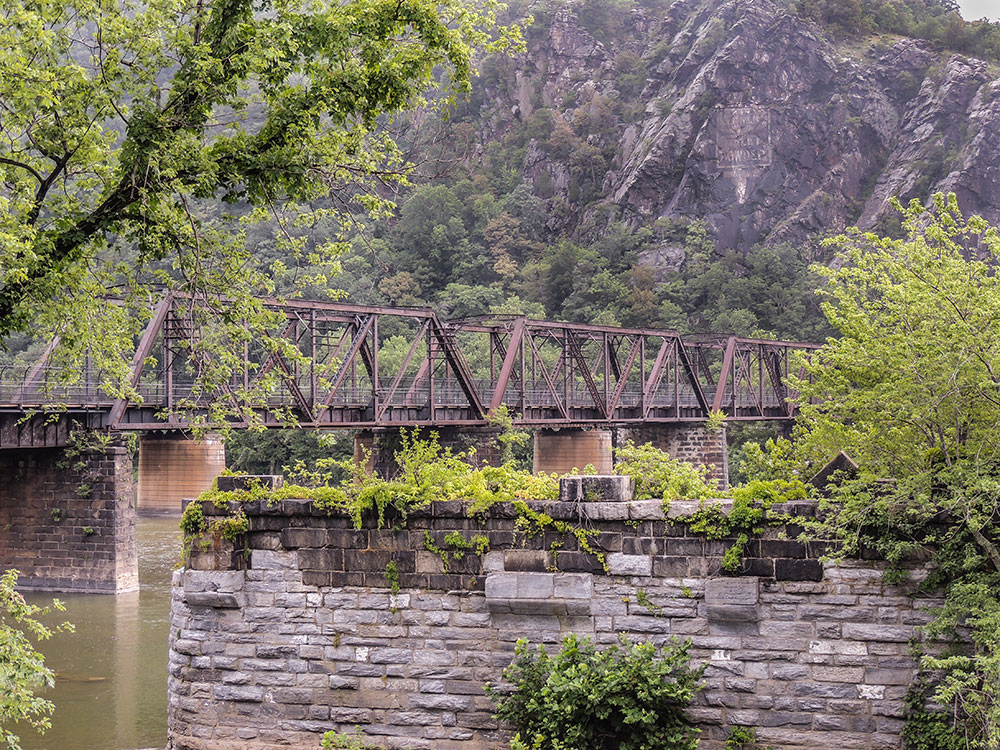General Information
How to Get There
Overview
Harpers Ferry is a historic town in West Virginia, in the lower Shenandoah Valley. (Until 1863, it was in Virginia.) It is situated at the confluence of the Potomac and Shenandoah rivers, where Maryland, Virginia, and West Virginia meet. It is the easternmost town in West Virginia and during the Civil War was the northernmost point of Confederate-controlled territory.
The most important event in the town's history was John Brown's raid on the Harpers Ferry Armory, in 1859. John Brown's Fort is the most visited tourist site in the state of West Virginia.
The geographical and physical features of Harpers Ferry were the principal reasons for its settlement and eventual industrial development. It is a natural transportation hub. A major river, the Shenandoah, joins the Potomac River at Harpers Ferry. It guarded the entrance to Virginia's large Shenandoah Valley, and the Potomac provided easy access to Washington. The rivers' valleys made it possible to build the never-completed Chesapeake and Ohio Canal, and then the Baltimore and Ohio Railroad and shortly after the Winchester and Potomac Railroad. The first railroad junction in the United States was at Harpers Ferry. Essential telegraph lines passed through the town.
The Arsenal, and later other industries, were located in Harpers Ferry because of the abundant water power available from the rivers.
The town's original, lower section is on a flood plain created by the two rivers. It is surrounded by higher ground, and since the 20th century has been part of Harpers Ferry National Historical Park. Most of the remainder, which includes the more elevated populated area, is included in the separate Harpers Ferry Historic District. Two other National Register of Historic Places properties adjoin the town: the B & O Railroad Potomac River Crossing and St. Peter's Roman Catholic Church.
The Appalachian Trail Conservancy (ATC) headquarters is in Harpers Ferry. The Appalachian Trail passes directly through town. Other popular outdoor activities include white water rafting, fishing, mountain biking, tubing, canoeing, hiking, zip lining, and rock climbing.
On October 16, 1859, the abolitionist John Brown led a group of 22 men (counting himself) in a raid on the arsenal. Five of the men were black: three free black men, one freed slave, and one fugitive slave. Brown attacked and captured several buildings, hoping to secure the weapons depot and arm the slaves, starting a revolt across the South.
The noise from that shot alerted Dr. John Starry shortly after 1:00 am. He walked from his nearby home to investigate the shooting and was confronted by Brown's men. Starry stated that he was a doctor but could do nothing more for Shepherd, and Brown's men allowed him to leave. Starry went to the livery and rode to neighboring towns and villages, alerting residents to the raid. John Brown's men were quickly pinned down by local citizens and militia, and forced to take refuge in the fire engine house (later called John Brown's Fort), at the entrance to the armory.
The Secretary of War asked the Navy Department for a unit of United States Marines from the Washington Navy Yard, the nearest troops. Lieutenant Israel Greene was ordered to take a force of 86 Marines to the town. U.S. Army Lieutenant Colonel Robert E. Lee was found on leave at his home in nearby Arlington, and he was assigned as commander, along with Lt. J. E. B. Stuart as his aide-de-camp. The contingent arrived by train on October 18, and after negotiations failed, they stormed the fire house and captured most of the raiders, killing a few and suffering a single casualty.
Brown was quickly tried in Charles Town, county seat of Jefferson County, for treason against the Commonwealth of Virginia, murder, and fomenting a slave insurrection. Convicted of all charges, he was hanged December 2, 1859. (See Virginia v. John Brown.)
Harpers Ferry National Historical Park, originally Harpers Ferry National Monument, is located at the confluence of the Potomac and Shenandoah rivers in and around Harpers Ferry, West Virginia. The park includes the historic center of Harpers Ferry, notable as a key 19th-century industrial area and as the scene of John Brown's failed abolitionist uprising. It contains the most visited historic site in the state of West Virginia, John Brown's Fort.
The park includes land in the Shenandoah Valley in Jefferson County, West Virginia; Washington County, Maryland and Loudoun County, Virginia. The park is managed by the National Park Service. an agency of the U.S. Department of the Interior. Originally designated Harpers Ferry National Monument in 1944, the park was declared a National Historical Park by the U.S. Congress in 1963. Due to a mixture of historical events and ample recreational opportunities, all within 50 miles (80 km) of Washington, D.C., the park was listed on the National Register of Historic Places on October 15, 1966.
The Lower Town points of interest are clustered where the Shenandoah River meets the Potomac River, and run along Shenandoah Street, Potomac Street and High Street:
- Information Center
- Restoration Museum
- Frankel's Clothing Store
- Industry Museum
- Bookshop
- Blacksmith Shop
- Hamilton Street
- A Place in Time Museum
- Provost Marshal Office
- Stipes' Boarding House
- Dry Goods Store
- Arsenal Square
- John Brown's Fort
- The Point
- John Brown Museum
- Wetlands Museum
- Storer College/Niagara Movement Museum
- A. Burton Clocks and Jewelry Exhibit
- 1862 Battle of Harpers
- Ferry Museum
- Confectionery Exhibit
- Civil War Museum
- Black Voices Museum
- White Hall Tavern
- Meriwether Lewis Exhibit
- Harper House
- Jefferson Rock
- Harper Cemetery
The Harpers Ferry Historic District comprises about one hundred historic structures in Harpers Ferry, West Virginia. The historic district includes the portions of the central town not included in Harpers Ferry National Historical Park, including large numbers of early 19th-century houses built by the United States Government for the workers at the Harpers Ferry Armory. Significant buildings and sites include the site of the Armory, the U.S Armory Potomac Canal, the Harpers Ferry Train Station, and Shenandoah Street, Potomac Street, and High or Washington Street. The National Historic Park essentially comprises the lower, flood-prone areas of the town, while the Historic District comprises the upper town.
In the late 19th century a number of Victorian and Federalist-style houses were built on the high ground. The historic district preserves what is essentially an intact 19th-century town that occupied a pivotal role in the American Civil War, and later as a transportation center.
This article uses material from the Wikipedia article "Harpers Ferry, West Virginia", "Harpers Ferry National Historical Park", and "Harpers Ferry Historic District", which is released under the Creative Commons Attribution-Share-Alike License 3.0

